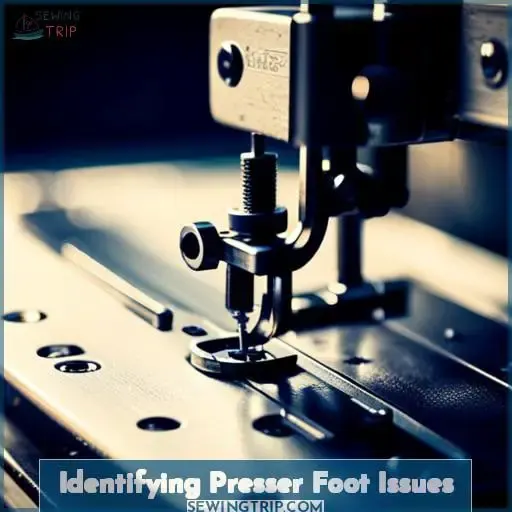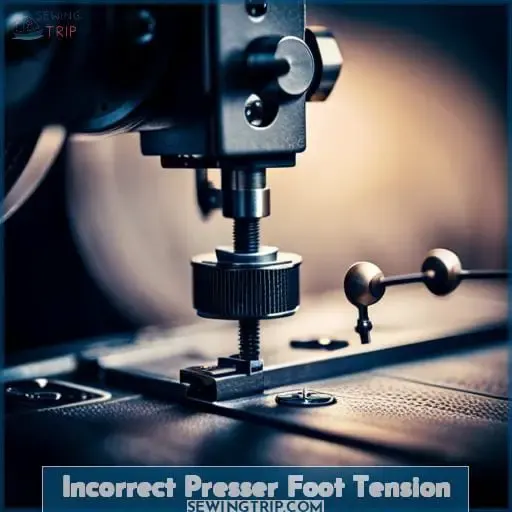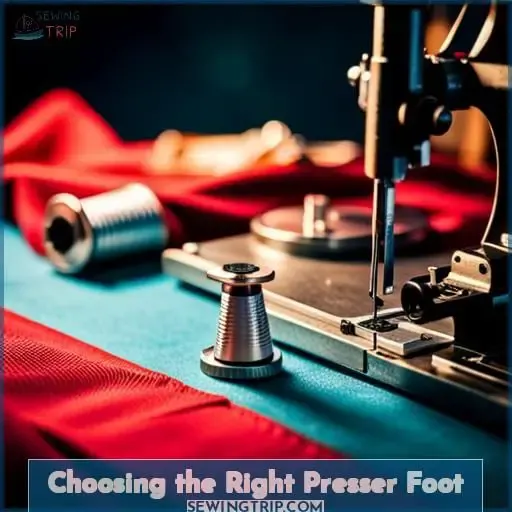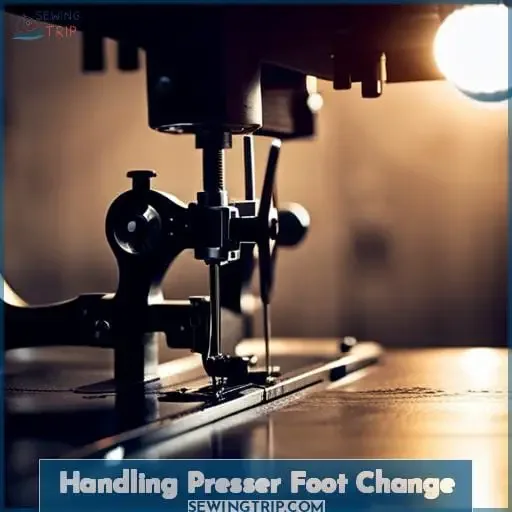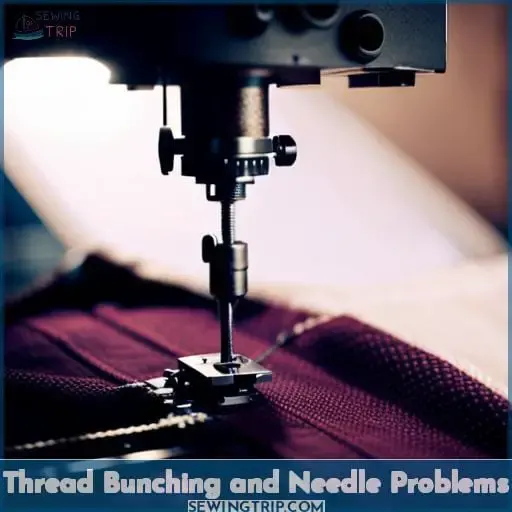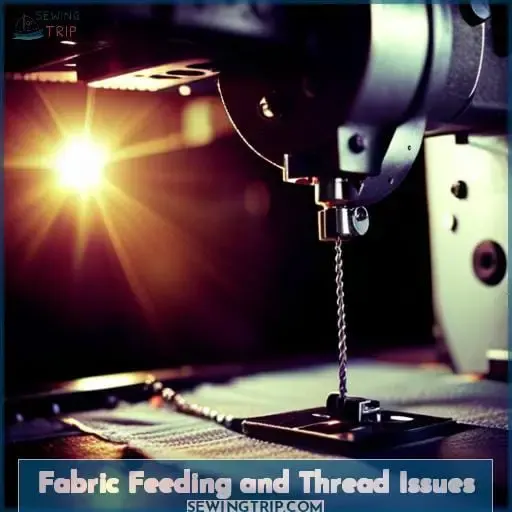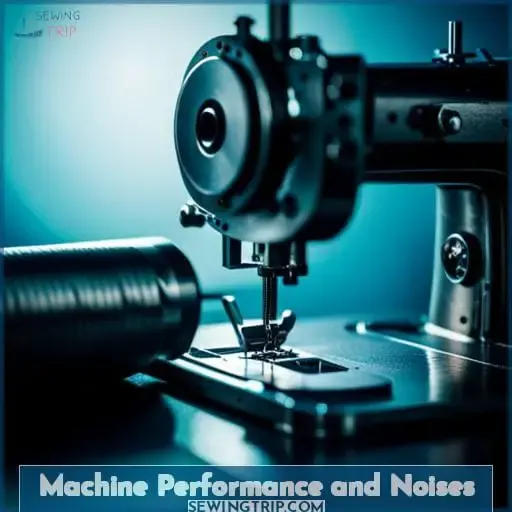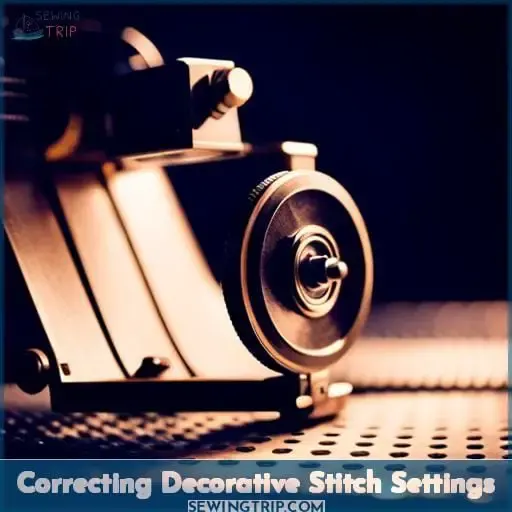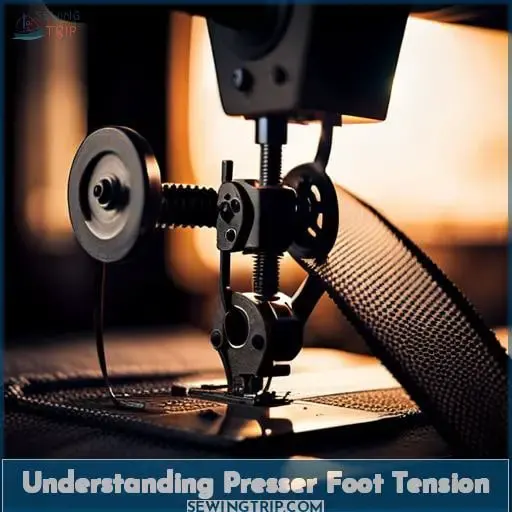This site is supported by our readers. We may earn a commission, at no cost to you, if you purchase through links.
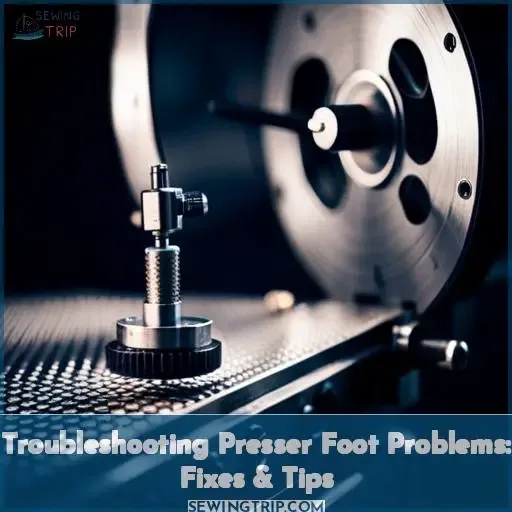 Embark on a journey through the intricate world of sewing machine mechanics, where the presser foot is your steadfast companion.
Embark on a journey through the intricate world of sewing machine mechanics, where the presser foot is your steadfast companion.
Picture this: your presser foot, a humble hero, gliding gracefully over fabrics, orchestrating the perfect dance between needle and thread. Yet, even heroes face trials. In the realm of stitching, presser foot problems can surface, disrupting your creative flow.
Imagine stitching fabric without this foot’s steadfast guidance – a scene both frustrating and chaotic. Fear not, for in this article, we delve into the realm of presser foot predicaments, equipped with solutions that empower you to conquer these challenges with finesse.
As you thread your way through these pages, you’ll uncover the art of diagnosing presser foot glitches – from incomplete lowering causing fabric unrest to the enigmatic world of tension imbalances.
Mastery over specialized presser feet for diverse fabrics shall be at your fingertips, while the elusive skill of changing the presser foot with ease will become your second nature. Fear not the thread tangles, needle breakages, or fabric feeding fiascos, for we stand ready to illuminate the path to resolution.
Together, we will decode the symphony of sewing machine sounds and decode the language of decorative stitch settings. Brace yourself, as we demystify the enigma of presser foot tension, equipping you to wield the pressure dial with confidence.
Liberation from presser foot predicaments, mastery over your machine, and a profound understanding of sewing mechanics await you.
Table Of Contents
- Key Takeaways
- Identifying Presser Foot Issues
- Incomplete Lowering and Its Solutions
- Incorrect Presser Foot Tension
- Choosing the Right Presser Foot
- Handling Presser Foot Change
- Thread Bunching and Needle Problems
- Fabric Feeding and Thread Issues
- Machine Performance and Noises
- Correcting Decorative Stitch Settings
- Understanding Presser Foot Tension
- Conclusion
Key Takeaways
- The presser foot is a crucial component in sewing machine mechanics.
- Presser foot issues can cause stitching problems.
- Adjusting presser foot tension can help address stitching issues.
- Different fabrics require specific presser feet for optimal sewing.
Identifying Presser Foot Issues
Ready to dive into the world of sewing intricacies? Discovering common symptoms that signal presser foot problems can save your masterpiece from becoming a frustrating tangle of fabric. When you notice your fabric isn’t feeding smoothly or your stitches are uneven, it’s time to put your troubleshooting skills to work.
Start by checking the presser foot tension and making adjustments as needed. If the fabric isn’t moving smoothly, inspect the feed dogs for any obstructions. Sometimes, a simple presser foot adjustment can make all the difference in your stitching experience.
Incomplete Lowering and Its Solutions
Addressing the incomplete lowering concern involves adjusting the presser foot tension, a crucial step in preventing fabric movement and stitch irregularities.
To troubleshoot and rectify this issue effectively, follow these steps:
-
Release Screw: Locate the corresponding tension adjustment screw for the presser foot. Gently release the foot from its current position.
-
Adjust Tension: With precision, modify the tension by turning the tension screw. Gradually increase or decrease the tension to find the balance that suits your fabric type.
-
Secure Alignment: Once tension is adjusted, securely reposition the presser foot. Ensure proper alignment and tighten the screw.
Maintaining appropriate presser foot tension is integral to seamless sewing. Mastering tension troubleshooting guarantees optimal stitching results, setting you on a path to sewing success.
Incorrect Presser Foot Tension
Navigating the intricacies of sewing machine mechanics, you’re well aware that improper presser foot tension can lead to frustrating stitching woes. Picture this: high tension causing those aggravatingly bunched stitches, and conversely, low tension resulting in an exasperating sideways fabric drift.
Let’s delve into the realm of tension-related presser foot predicaments and the savvy fixes that will have you stitching seamlessly again.
High Tension and Bunchy Stitches
Feeling frustrated with your stitches turning into unsightly tangles? Adjusting the tension dial to the right level is your ticket to smooth, even sewing on any fabric weight. Achieve stitch quality enhancement by mastering the art of thread tension adjustment.
Prevent fabric bunching and gather-free sewing with precise tension control. Your sewing techniques and adjustments become your trusted allies, ensuring frustration-free, professional-quality stitching every time.
Low Tension and Sideways Movement
As you adjust the tension control on your sewing machine, you’ll discover the delicate balance between low tension and sideways movement – a crucial factor in achieving flawless stitches on various fabrics.
It’s a dance of equilibrium that ensures clean, perfect results. When the tension is too low, the fabric may wander and the stitches will suffer. But don’t worry, as you master tension control, those frustrations with broken needles and incorrect tension will become a thing of the past.
Choosing the Right Presser Foot
Navigating the intricate world of sewing machine accessories demands a keen eye for selecting the right presser foot – a pivotal choice that can make or break your fabric and stitch endeavors. The art lies in embracing the specialized presser feet tailored to conquer the challenges posed by distinct materials, ensuring your projects unfold with finesse and professional precision.
Importance of Proper Selection
Ensure you pick the right tool from the array of specialized options available to achieve flawless stitches and impeccable fabric handling, ultimately enhancing your sewing endeavors. Choosing accessories goes beyond functionality; it’s about understanding your machine’s needs.
Compatibility considerations are crucial, as specialty feet benefits vary with brands. User feedback reveals effective techniques and the importance of proper selection in addressing presser foot pressure and fabric sliding issues.
Specialized Presser Feet for Specific Fabrics
Discover the perfect solution for tackling challenging fabrics with specialized presser feet tailored to specific material types. When delving into leather sewing techniques, consider a walking foot that ensures smooth movement, preventing skipped stitches.
For vinyl stitching tips, a non-stick presser foot eliminates drag, guaranteeing precise stitches. Seam guide feet come in handy for intricate fabric sewing, aiding in maintaining accurate seam allowances.
Handling Presser Foot Change
Navigating the realm of presser foot adjustments requires a deft touch and a keen eye for detail. As you delve into the pivotal aspects of maintaining a seamless stitching process, mastering the art of smoothly transitioning presser feet and conducting thorough post-replacement evaluations will become second nature.
Smooth Foot Change Process
Mastering the art of seamlessly changing your presser foot is a key aspect of maintaining a fluid and uninterrupted sewing process.
-
Machine Power Off: Always turn off your sewing machine before changing the presser foot to avoid accidents.
-
Needle Position: Raise the needle to its highest position using the handwheel to provide clearance for the presser foot change.
-
Presser Foot Lever: Engage the presser foot release lever to easily remove the current foot.
-
Gentle Alignment: When attaching the new foot, align the fork of the foot with the presser bar and lower it carefully to secure.
By adhering to these easy maintenance tips, you’ll ensure effective replacement, prevent sewing machine issues like the needle not moving or thread bunching, and maintain correct thread tension throughout your sewing journey.
Post-Replacement Checks
Smoothly transitioning from one phase to the next in your sewing journey is like threading a needle – it requires precision and finesse to ensure your stitches align flawlessly. After replacing your presser foot, perform essential post-replacement checks. Verify the correct position and tension of the presser foot.
Make sure it is the appropriate foot type for your project, whether it is a walking foot for slippery fabrics or a seam guide foot for precise seam allowances. This meticulous assessment of the sewing foot prevents fabric puckering, uneven stitches, or feeding dog issues, ensuring a seamless sewing experience.
Thread Bunching and Needle Problems
Delving deeper into sewing machine mechanics, it’s time to address the persistent headaches: thread bunching under fabric and the enigma of bent or broken needles. These issues can abruptly unravel your creative flow, but fear not, for understanding their roots and mastering their remedies will keep you stitching away seamlessly.
Thread Bunching Under Fabric
Address the issue of thread bunching by ensuring your needle is properly threaded and the tension is appropriately adjusted for a seamless sewing experience. Troubleshoot needle issues by confirming it is the right size for the fabric. Prevent stitch irregularities by checking bobbin thread problems and consistently adjusting the upper thread tension.
Inspect your presser foot for proper alignment, as it plays a crucial role in consistent feed, preventing fabric puckering, and avoiding thread bunching under fabric.
Bent or Broken Needles
When handling your sewing tasks, it is crucial to be mindful of any bent or broken needles, as these unexpected glitches can easily snag your progress and disrupt the fluidity of your stitching process.
Ensure needle maintenance by selecting the appropriate needle material and size. Check needle alignment and promptly replace any bent or damaged needles. Neglecting this can lead to presser foot problems, unthreading, puckered seams, and decorative stitches not working as intended.
Fabric Feeding and Thread Issues
When troubleshooting sewing machine problems, you’ll encounter issues like fabric not feeding properly, thread breakage, and inconsistent tension. These challenges can disrupt your sewing flow, but with the right expertise, you can address them effectively and keep your sewing machine running smoothly.
Fabric Not Feeding Properly
Ensure your fabric feeds flawlessly to avoid frustrating interruptions in your sewing flow. When facing fabric not feeding properly, start by examining your presser foot. A mismatched presser foot can hinder material movement and compromise stitch quality.
Opt for the right presser foot that suits your material – walking feet for slippery fabrics, standard feet for regular sewing. Additionally, check your sewing techniques as pulling or pushing the fabric can also cause feeding issues.
By addressing presser foot problems and choosing the correct foot, you’ll master smooth fabric feeding and elevate your sewing projects.
Thread Breakage and Inconsistent Tension
Tackle thread breakage and uneven tension like a pro with smart sewing machine adjustments and the right accessories. When thread breaks or tension wavers, it’s likely due to incorrect settings or incompatible presser feet.
Start by rethreading your machine, ensuring it’s properly seated in the tension discs. Check that the thread spool isn’t getting caught and causing resistance. If the thread keeps snapping, try adjusting the tension dial incrementally.
For persistent issues, consider a presser foot change – sometimes a different foot can provide smoother thread flow.
Machine Performance and Noises
To effectively troubleshoot and address issues affecting your sewing machine’s performance, you’ll want to delve into the realm of skipping stitches and machine seizures, as well as strange noises and needle movement.
Your expertise in sewing machine mechanics allows you to confidently diagnose these problems and implement the necessary maintenance steps to ensure a smooth and uninterrupted sewing experience.
Skipping Stitches and Machine Seizures
Addressing skipping stitches and machine seizures involves understanding the dynamics of your sewing machine’s performance and the sounds it produces during operation. When your sewing machine presser foot problems intersect with skipped stitches, it’s often a needle issue.
Troubleshooting needle issues means ensuring it is the right size and type for your fabric. Addressing thread tangles and bobbin thread problems also alleviates skipping stitches. To tackle machine seizing up and fabric jamming, inspect the bobbin case. By delving into these intricacies, you liberate your sewing prowess.
Strange Noises and Needle Movement
Amidst the mechanical melody of sewing, listen closely for the clatter of curious clinks and the dance of the needle’s melody, signaling strange symphonies of unseen shifts. Unusual sounds and needle vibrations might be more than just random disruptions; they could be the harmony of a deeper issue.
When presser foot problems arise, they can lead to needle jamming, stitch skipping, and perplexing noise patterns. A meticulous noise analysis becomes your compass, guiding you through the labyrinth of sewing machine intricacies.
Don’t let the dissonance linger; master the art of deciphering these auditory cues for flawless sewing results.
Correcting Decorative Stitch Settings
Navigate the realm of enhancing your decorative stitch settings with a flair that stirs your creative soul, propelling you to experience the sheer joy of sewing mastery.
Troubleshooting Thread Art becomes an art in itself, where your fabric transforms into a canvas and the presser foot a brush.
Delve into Stitch Balance, finding the sweet spot where tension orchestrates perfection.
Experiment with Stitch Variations, embracing the delightful dance of patterns and textures.
Let Embellishment Tips be your secret recipe for exquisite designs.
As you adjust Stitch Length, witness your creations evolve from subtle elegance to bold statements.
The sewing machine presser foot is your ally, ensuring fabric and stitches unite seamlessly, while Singer sewing machines unravel endless possibilities.
With each sewing project, you’ll inch closer to Liberation, Mastery, Understanding.
Understanding Presser Foot Tension
Embarking on your sewing journey, you grasp the pivotal role of tension in the intricate dance of fabric and thread. Mastering the interplay between the pressure dial and sewing machine adjustments becomes your compass, guiding you toward the elusive perfect stitch.
Recognizing Correct Tension
Recognizing correct tension is pivotal – it’s the thread’s perfect balance that orchestrates the symphony of flawless stitches on your fabric masterpiece.
- Bobbin Tension: Understand how to set the right bobbin tension, ensuring upper and lower threads intertwine seamlessly.
- Thread Fraying: Master tension to prevent thread fraying, maintaining thread integrity throughout your sewing journey.
- Thread Breaking: Achieving balance prevents thread breakage, allowing you to stitch uninterrupted and produce impeccable results.
Pressure Dial and Sewing Machine Adjustment
Adjust the pressure dial and fine-tune your sewing machine settings to ensure even stitches and smooth fabric feeding. A well-calibrated pressure dial is crucial for optimal tension levels and enhancing stitch quality.
Master thread control techniques by understanding the interplay between the sewing machine presser foot and pressure regulator. Test your adjustments on scrap fabric to achieve mastery in sewing machine performance.
Conclusion
To the dedicated sewers who fear the frustration of presser foot problems, fret not. The world of fabric mastery need not be fraught with hurdles. Yes, even when dancing with tricky materials like leather or vinyl, the SINGER Non-Stick Snap-On Presser Foot emerges as your steadfast ally.
Compatibility with an array of sewing machines, a sleek design ensuring smooth glides, and the banishment of drag—these make your sewing escapades a joy. So, as you tread the path of stitches, remember, conquering presser foot problems is your newfound prowess.

